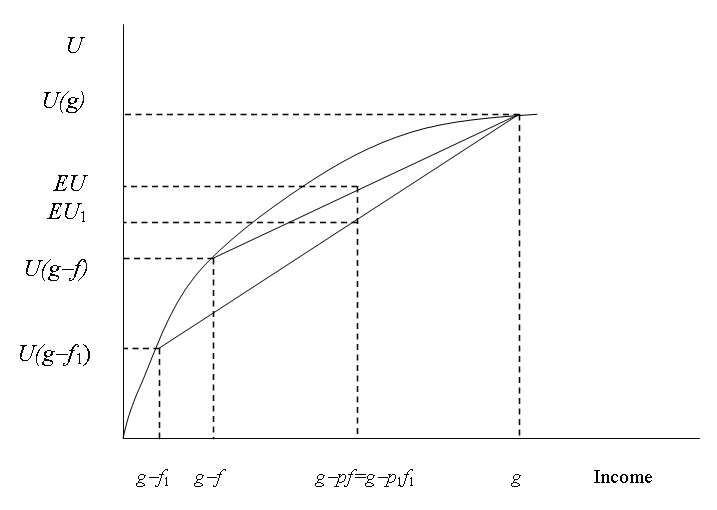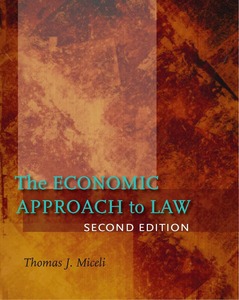Chapter 9
The deterrence effect of fines versus the probability of apprehension
Group punishment
Civil disobedience
Debtors’ prisons
The deterrent effect of fines versus the probability of apprehension
The economic model of crime developed in the text is based on the notion that rational offenders compare the gain from committing and illegal act to the expected punishment. In the case of a fine, the offender commits the act if and only if g>pf. Based on this logic, any change in p or f that keeps the produce constant should have no effect on the crime rate. This assumes, however, that criminals are risk-neutral. More generally, suppose that a criminal has expected utility of committing a crime given by
EU = (1•p)U(g) + pU(g•f), (1)
where U is the offender’s utility function over income. Now suppose that f is raised to f1 and p is lowered to p1 so as to keep pf constant (i.e., pf=p1f1). Will that raise or lower EU? The following graph shows the effect for the case of a risk-neutral offender.
 According to the graph, EU1<EU, meaning that the proposed change lowers the expected utility of the offender. As a result, deterrence is increased. Intuitively, although the expected fine and expected income remain the same, the variability of the offender’s income is increased (i.e., the range between g and g•pf is larger), which makes his gamble riskier. And since the offender is risk averse, this lowers his expected utility. The reverse would be true if the offender were risk loving.
According to the graph, EU1<EU, meaning that the proposed change lowers the expected utility of the offender. As a result, deterrence is increased. Intuitively, although the expected fine and expected income remain the same, the variability of the offender’s income is increased (i.e., the range between g and g•pf is larger), which makes his gamble riskier. And since the offender is risk averse, this lowers his expected utility. The reverse would be true if the offender were risk loving.
As a practical matter, this suggests that uncertainty in enforcement may be a valuable form of deterrent, apart from the impact on cost. For example, if most tax payers are risk averse, then the uncertainty of tax audits may contribute to their deterring effect on evasion, while at the same time lowering the cost of enforcement.
Group punishment
In the standard law enforcement model surveyed in Chapter 9, the enforcement authority identifies and punishes a single offender. In many enforcement situations, however, while the identity of the offender is uncertain, he is known to be a member of a well-defined group. Examples include a class prankster, a terrorist known to be from a certain group or country, and a polluter known to be located in a particular geographic region. In this context, the law enforcer can either seek to identify the particular offender as in the standard model (individual punishment), or it can punish the entire group (group punishment). Examples of the latter strategy include keeping the entire class after school for the actions of the prankster, sanctioning a country known to harbor terrorists, and imposing liability for pollution on an entire industry or group of firms.
The fundamental trade-off involved in choosing between individual and group punishment is as follows. The advantages of group punishment are (1) the offender is punished with certainty (thereby enhancing deterrence), (2) detection costs are saved, and (3) the threat of group punishment may induce members of the group to identify and turn over the offender, and/or to invest in efforts to deter future offenses by its members. The chief disadvantage of group punishment is that innocent individuals are punished.
Historically, group punishment is more reflective of ancient and primitive societies, where group responsibility was common. (For example, biblical descriptions of group punishment schemes abound.) This makes sense given the general absence of a centralized law enforcement mechanism in ancient society. In contrast, improvements in the technology of law enforcement, along with increasing aversion to punishing the innocent, are consistent with the modern reliance on individual punishment. Still, group punishment is not unheard of in modern society, as the above examples suggest.
It is an interesting exercise to challenge students to think of group punishment schemes that they have heard about or experienced, and to discuss why they are used in those contexts.
For a detailed examination of this issue, see Thomas J. Miceli and Kathleen Segerson (2007) “Punishing the Innocent Along with the Guilty: The Economics of Individual versus Group Punishment,” Journal of Legal Studies 36: 81-106.
Civil disobedience
Civil disobedience (CD) represents a form of protest against an unjust or immoral law by an individual or small group of individuals who hope to overturn the law by openly violating it and bearing the consequences. CD holds a prominent place in the American tradition of distrust of government authority, dating back at least to Thoreau. The two essential features of CD seem to be (1) open violation of the law with no effort to evade punishment, and (2) an effort to persuade others by this act that the law is unjust and should be changed. What, if anything, can economic theory say about CD?
Let us begin to think about CD in the context of the rational offender model. The benefit to the offender consists of his or her personal gain, g, from violating a law deemed unjust, plus the expected future gain from the possibility that the law may be overturned as a result of the violator’s act. Call this gain qG, where q is the probability that the law will be overturned and G is the resulting gain. The cost of the offense is the sanction, s, which will be imposed with certainty since the offender, by hypothesis, will take no steps to evade apprehension. Thus, the offender will commit the act of CD if
g + qG • s. (1)
Alternatively, someone who disagrees with a law can simply violate it and then try to avoid capture as in the standard offender model. In this case, the offender has no intention of making a political statement, but as a result, the expected sanction is ps, where p is the probability of apprehension. The offender follows this strategy if
g • ps. (2)
Obviously, if neither (1) nor (2) are satisfied, the individual will obey the law, as is true for the vast majority of citizens. But if one or both are satisfied, the offender will choose the form of violation that yields the higher net gain. For a given g, CD will be the preferred choice if
q > ![]() . (3)
. (3)
Generally, therefore, CD is more likely to occur the larger are q, G, and p, and the smaller is s. As a practical matter, however, (3) reveals at least two reasons why CD is in fact rare. First, for most laws, q will be nearly zero since a single protester will not often be able to persuade the government to change the law in question. (The argument is similar to economic theories of voting, which have a hard time explaining why rational individuals would vote, given the miniscule likelihood that any one person’s vote will be decisive.) Second, the offender’s private gain from having the law overturned, G, may be considerably smaller than the social gain (assuming that the law is truly unjust) since that gain will be enjoyed by all citizens, whereas only the offender bears the sanction. Thus, the decision to commit CD is subject to the usual free-rider problem associated with public goods.
Debtors’ prisons
Imprisonment for failure to repay debt was a common practice throughout the world (including the U.S.) into the nineteenth century. The puzzle that debtors’ prisons pose is, how can the indebted person be expected to repay the loan while in prison? The usual argument is that family members or friends will raise the requisite funds to secure the release of the prisoner.
But consider a different perspective on the threat of imprisonment for default that is based on the economic model of crime. Consider a borrower who obtains a loan of L dollars for purposes of starting a business. The business will either prosper, in which case the borrower will be able to repay the loan plus the interest, or it will fail, in which case he will default. Suppose the probability that the business will prosper is p. Thus, the expected return to the lender is
pL(1+r) (1)
where r is the interest rate. (This assumes that the borrower repays nothing in the event of default.)
The lender is willing to make the loan under these conditions if the expected return is large enough. Suppose in particular that the lender’s next best investment yields a safe return of L(1+k). Thus, he will make the loan if pL(1+r)• L(1+k), or if
p • ![]() . (2)
. (2)
Obviously, r>k is necessary for the lender to be willing to make a loan when there is any risk of default (i.e., when p<1). This reflects the risk premium. Thus, in the event that the business prospers, the borrower pays back L(1+r), which yields the lender a positive profit over his next best option, but in the event of default, the borrower pays nothing and the lender suffers a loss (i.e., the lender forgives the loan). In expected terms, however, the lender more than breaks even.
So what is the role of debtor’s prison in this scheme? One problem with the above loan contract is that it requires the lender to be able to observe the outcome of the borrower’s business venture—that is, whether or not it prospers. This may be difficult or impossible. As a result, it will be in the borrower’s interest to claim a default, even though the business has prospered, so as to avoid paying back the debt. The function of debtors’ prison is to deter this sort of misrepresentation.
Specifically, suppose that if a borrower claims default, he will have to go to prison for a period of time T. Let the unit cost of imprisonment to the borrower be c. The question is, what length of imprisonment will just deter the borrower from falsely claiming default? The condition is
L(1+r) • cT
or
T • ![]() . (3)
. (3)
Note that the required prison term is longer the larger is the loan, and the larger is the interest rate (which reflects a higher risk loan). Together, conditions (2) and (3) describe the requirements for the loan market to exist given the lack of collateral and the unobservability of the borrower’s income.
It is important to note that, although condition (3) deters false reporting of default, borrowers who truly default have no other option but to go to prison. Thus, some imprisonment for debt is unavoidable as long as loans are risky. The same is true, of course, of criminal penalties in general. Although intended to deter crime, they must be imposed on those offenders who are not deterred in order to make the threat of punishment credible.
